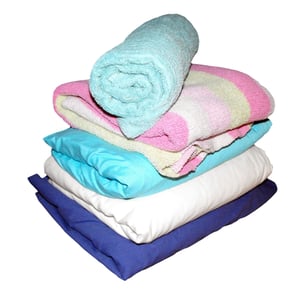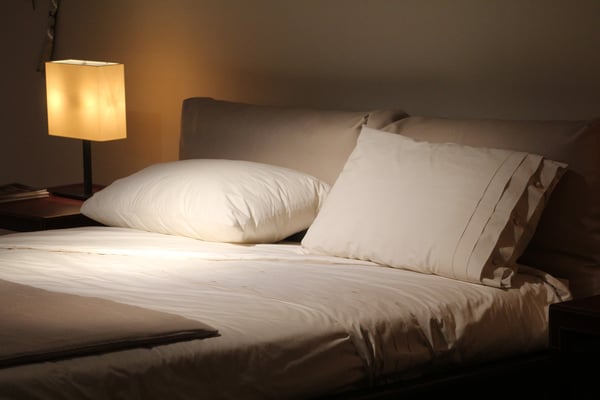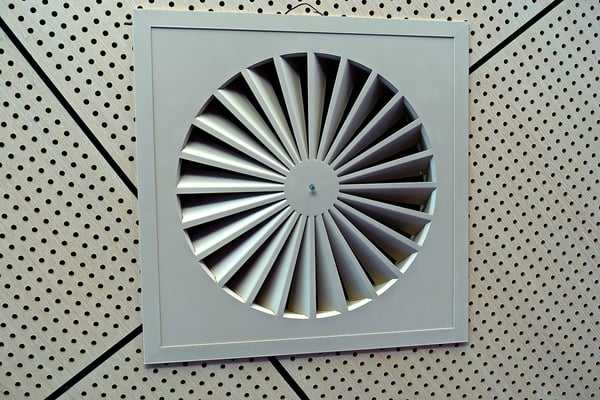For people who have COPD, living in a clean environment should be a top priority. Because the disease makes the lungs hyper-sensitive to irritants, even small amounts of dust and allergens can set off coughing fits and make daily COPD symptoms worse.
Unfortunately, there are many places in your home that can trap particles that irritate your lungs, and it can be difficult to track them all down. Harmful particles can accumulate in your carpet, furniture, and all the nooks and crannies of your home, where they lie in wait until they get stirred up into the air you breathe.
One of these hidden sources of respiratory irritants could be your bedding, which is an oft-overlooked hot spot for dust and allergens. Many people don't realize how quickly their pillows, mattresses, and bed sheets can accumulate hazardous particles that can trigger COPD symptoms.
In this article, we're going to show you how to get rid of dust, mold, dust mites, and other particles in your bedding and keep them away for good. That way, you can rest assured every night knowing your lungs are protected while you sleep.
A Very Real Hazard
_Lorryia_formosa_2_edit.jpg?width=300&name=Yellow_mite_(Tydeidae)_Lorryia_formosa_2_edit.jpg)
It's easy to underestimate the dangers that respiratory irritants in your sheets, pillows, and mattress can pose for your lungs if you have COPD. However, based on how much time you spend in and around your bed, it should not be difficult to imagine how being exposed to them night after night could affect your lungs on a daily basis.
Because you spend so much time in your bedroom, keeping it clean and lung-friendly should be one of your top priorities. Most people spend a minimum of seven to eight hours in their bed every night, and it can have a significant affect on your ability to breathe if you are surrounded by hazardous particles and allergens while you sleep.

If you don't take special precautions, dust, mold, pollen, and other irritants that live in your bed enter your lungs at night when you breathe. This can inflame your lungs, causing you to wake up with worse symptoms that can last throughout the day.
That's why it's so important to give your bedding some extra attention if you have COPD. Just being more careful and deliberate in the types of fabrics you use and how you care for them can go a long way toward improving your COPD symptoms.
The Hazards Hiding in Your Sheets

According to a microbiologist from the New York School of Medicine, beds are uniquely prone to collecting all kinds of nasty and potentially hazardous substances. “You have spores of fungi, bacteria, animal dander, pollen, soil, lint...” he says, along with skin cells, oils, cosmetics, and bodily secretions, among others.
While some of these are simply gross, others can actually be dangerous for your lungs, especially if you have COPD. Dust mites, mold, pollen, and pollutant particles, in particular, can inflame your lungs, cause uncomfortable symptoms, and exacerbate your COPD.
Dust Mites

Wherever there's fabric, there's a good chance there is an invisible army of dust mites living in the fibers. Dust mites live off of dead skin, dust and fibers, and thrive in places like your carpet, furniture, and—you guessed it—your bedding.
Dust mites particularly like anything that's made with plush or layered fabrics like pillows, comforters, mattresses, and thick blankets. These items tend to trap lots of dust and dead skin for the little bugs to to munch on.
While they don't affect everyone, dust mites cause many people to experience symptoms like coughing, sneezing, and nasal congestion when they're around. If you have COPD and are sensitive to dust mites, exposure to the mites in your mattress and bedding can inflame your lungs and airways and make your COPD symptoms worse.
Mold

Mold is another respiratory irritant that could be lurking in your pillows, mattress, or bed sheets. Exposure to mold can irritate your lungs and cause a variety of uncomfortable symptoms, including coughing, wheezing, nasal stuffiness, eye irritation, and even skin irritation in some cases.
Some people are more sensitive to mold than others, but patients with COPD should be careful to steer clear of damp, moldy environments. That includes looking out for mold growth in your home, including in your fabrics and bedding.
Bed sheets, blankets, and other fabrics can get moldy after you wash them if you leave them sitting in the washer too long or don't dry them out quickly enough. You can usually tell if they've grown any mold because they'll have a musty, mildew odor, even after they've dried.
Your mattress and pillows can collect mold, too, if they get get wet for any reason. That's why it's important to avoid spilling water in your bed and to dry up any damp spots immediately.
If you live in a humid climate, things will get damp easier and dry out more slowly, which means you'll need to be even more on the lookout for mold and mildew. It's also important to know that mold is almost guaranteed to grow in any place that stays damp for more than 24 hours, no matter where you live.
Keeping your bed free from mold is important for protecting your lungs and keeping respiratory symptoms at bay. If you have musty sheets or hidden mold in your mattress, it can cause your COPD symptoms to flare up and hurt your ability to breathe every day.
Pollen, Pollution, and Other Particles

When you go outside or spend time in a place with poor indoor air quality, any dust, pollen, or particle pollution you encounter sticks to your hair, clothes, and skin. If you aren't careful when you go home or get into bed, you can scatter these harmful particles around your home, into the air, and in your sheets.
Pollen and pollution levels tend to fluctuate between seasons and even from day to day, so your risk may change depending on where you live and the time of year. The particles can get in by hitching a ride on your person or by blowing in through open windows throughout the day.
If you have COPD, these allergens and pollutants can be especially dangerous, making it difficult to breathe and triggering COPD symptom flare-ups. Because the disease makes your lungs more sensitive to even small amounts of these irritants, it's important to take steps to minimize them in your bed and in your home.
How to Know if Your Bedding is the Problem

Many people experience worsened COPD symptoms at night and in the morning because they have trouble breathing while they sleep. In many cases, changing your sleeping position, using nighttime oxygen, or getting diagnosed and treated for sleep apnea can solve this problem.
However, sometimes worsened nighttime and morning COPD symptoms is a sign that there's something in your house or bedroom that's irritating your lungs while you sleep. This can cause you to experience worsened breathlessness during the night, which can make it difficult to fall asleep and deprive you of oxygen when you do.
As a result, you may wake up congested, fatigued, and feeling like your lungs and airways are inflamed. You might notice that your COPD symptoms are worse in the mornings and get better as the day goes on.
If this happens to you, make sure you talk to your doctor to make sure that you don't need nighttime oxygen or have an underlying sleep disorder or other problem. If the problem persists, it could be a sign that your bedding is exacerbating your COPD symptoms at night.
If so, then following the tips in this article to clean and care for your bedding could make a huge difference in how you feel every day. By removing a major source of respiratory irritants, it could make a significant difference in your ability to breathe and keep your COPD symptoms under control.
If you've taken care of your bedding, talked with your doctor, and you still notice your symptoms getting worse after spending time in your bedroom or at home, the air inside your house might be polluted. It could be a sign that you need to do a deep, whole-house cleaning and maintenance check to eradicate any other hidden sources of lung irritants in your home.
Here are some of the major symptoms of exposure to indoor respiratory irritants. If you experience these symptoms when you're at home, especially if they get worse after sleeping in your bed, it could be a a strong sign that your bedding is making your COPD worse:
Symptoms of exposure to indoor irritants (e.g. mold, dust mites, and other particles in your bedding):
- Nasal congestion
- Coughing
- Wheezing
- Shortness of breath
- Sneezing
- Itchy or runny nose
- Itchy and watery eyes
- Irritated, itchy skin or rashes
How to Keep Your Bedding COPD-Safe
Clean Your Sheets Often

The best way to get rid of the bulk of allergens and respiratory irritants is to wash your sheets, blankets, and covers often. It generally takes a week or more for them to accumulate in significant amounts, so a thorough wash once a week should be sufficient.
However, if you're like most people, you probably only change your sheets every couple weeks at most, or maybe even less often. Even though most people know they should wash their sheets more, it's an easy task to forget and neglect.
If you tend to put off washing your sheets or struggle to keep up with laundry, try to carve out a specific time in your schedule every week to throw all your bedding in the wash. Just be sure to use very hot water so it sanitizes the fabric and kills any mites or mold spores.
However, comforters and duvets can be washed less often since they don't usually come into direct contact with your skin. It's usually fine to wash these heavier top blankets about once every month or so.
Get an Extra Bedding Set

It's difficult to wash your sheets, pillow cases, and blankets often if you only have one set. To reduce the hassle, invest in a second bedding set so you can simply switch them out when one needs to be cleaned.
This makes it easier to change your sheets frequently and can really come in handy when there's an unexpected mess or spill in your bed. Just make sure to store your extra set of sheets and blankets away in a cool, dry place, preferably in a sealed container or linen bag.
Avoid Materials that May Trigger Allergies

Certain types of blankets and pillows are more likely to cause respiratory symptoms than others. For example, pillows and duvets stuffed with down feathers can trigger respiratory symptoms and breathing problems in people who are sensitive to the material.
If you experience worsened breathlessness or other COPD symptoms at night, you might want to check whether or not you are allergic to any of the materials or stuffing in your bed. If any of your pillows or blankets contain down or other allergy-triggering materials, try removing and replacing them with cotton-stuffed versions to see if your symptoms improve.
However, if you've removed any potential allergy-causing materials and still feel worse at night, then it's a good sign that something else is irritating your lungs. It could also be a sign that you are particularly sensitive to dust mites and need to dust mite-proof your bed.
Purchase Mattresses and Pillows that are Resistant to Dust Mites and Other Allergens

The types of fabrics and materials used in your bedding can make a big difference in how susceptible they are to dust mites and mold. Some materials tend to attract these respiratory irritants more readily, while others are more resistant.
If you have COPD, you might consider replacing your mattress and pillows with hypo-allergenic, dust mite-resistant versions. These products are made with materials designed to keep dust mites and other hazardous, lung-irritating particles from ever getting into their fibers in the first place.
Especially if you suffer from allergies, asthma, or are sensitive to dust mites and particles, getting hypo-allergenic products could help eliminate many of the irritants that trigger COPD symptoms at night. You may find that you sleep better, breathe better, and feel better during the day when you're not breathing in inflammatory particles all throughout the night.
Many hypoallergenic pillows and mattresses are made of allergy-resistant materials like latex, bamboo, and silk. You can often find them at department stores, mattress retailers, and in many shops online.
Choose Hypo-Allergenic Sheets and Blankets

Unfortunately, putting hypo-allergenic covers on your mattress and pillows won't do anything to protect you from irritants in your blankets and sheets. Aside from regular washing, the only way to have irritant-free sheets is to get them in an allergy-proof material.
For example, silk is naturally resistant to a variety of allergens and respiratory irritants, including dust mites, mold, and mildew. Wool is another great bedding material that repels dust mites and other allergens, and it's perfect for keeping your bed warm during the cold, winter months.
If you tend to sweat or overheat at night, you should also look for fabrics that are breathable and good at wicking moisture away so your bedding doesn't get musty. Wool is fantastic at wicking away moisture and can help keep your mattress dry at night.

Here is a list of some the best hypo-allergenic and COPD-friendly bedding materials:
- Bamboo: anti-microbial and resistant to mold and mildew
- Latex: anti-microbial and anti-bacterial
- Silk: resistant to dust mites, mold, and mildew
- Wool: resistant to dust mites and great at wicking away moisture
- Down and Hypodown: naturally dust mite-repellant and lightweight (Do not use down if you have a down allergy; use synthetic down alternatives or hypodown instead.)
Protect Your Mattress and Pillows

The next best thing to buying a new, allergen-resistant mattress and pillow is getting dust mite-resistant covers for your bed. Sometimes called allergy covers or hypo-allergenic covers, they provide an extra barrier to prevent dust mites from infesting the inside of your bed.
Dust mite-resistant covers work because they use a finely-weaved fabric that's so tight that dust mites can't crawl through. This can be especially useful for preventing dust mites from proliferating in your mattress and pillows when the weather turns humid and damp.
For the best results, you should keep the cover tightly zipped on your mattress and pillows all of the time from the minute you bring them into your home. It's important to use the covers consistently, because thy will do nothing against any dust mites that take up residence in the fibers when the cover is not in place.
While some research casts doubt on the effectiveness of hypo-allergenic mattress and pillow covers, other studies show that they can reduce symptoms and complications in people with allergies and asthma. This indicates they are also effective for people with other breathing disorders, including patients with COPD.
In fact, the Lung Institute Recommends that COPD patients use zippered, dust-mite proof cases on their pillows and mattress to reduce their symptoms at home. Especially if you know that you are sensitive to dust mites, dust mite covers can be a simple and effective way to eliminate another COPD trigger from your bedroom.
Be Careful What You Track In to Bed

While cleaning your covers and replacing your pillows regularly is important, there is plenty you can do to minimize the number of hazardous particles that make it into your sheets in the first place. You can do this by being especially careful about what you track into your bedroom and what you wear when you go to bed.
The clothes you wear accumulate all sorts of particles throughout the day no matter where you go. Even if you avoid pollution and do your best to stay away from respiratory irritants, the fibers in your clothes are bound to trap a certain amount of dust, pollen, mold spores, and particle pollution.
That's why you should always remove your clothes before getting in your bed unless they're fresh, clean bedclothes that you just slipped on. Never get into bed wearing anything you've gone out in or even worn about the house.
Instead, always remove your clothes and/or change into fresh clothing before you crawl under your shets. That's the only way you can make sure that none of the hazardous particles in your clothes get transferred onto your sheets.

Here are some more tips for keeping respiratory irritants out of your bed:
- Try showering at night before bed, instead of in the morning, to remove any dust, pollen, or other particles from your skin and hair.
- If you like to wear any clothes to bed, make sure they are clean and wait to put them on until right before you get in.
- Don't allow your pets to sleep with you or get in your bed, especially under the sheets.
- Don't put clutter, dirty clothes, jackets, shoes, or other items on your bed.
Keep Your Bed and Bedding Dry

If you're sensitive to mold or dust mites, then it's important to keep your sheets, blankets, pillows, and mattress as dry as possible at all times. Damp and humid environments encourage dust mites to multiply and mold spores to grow in your sheets.
Because moldy fabrics don't usually look moldy, it can be easy to miss or underestimate. And since dust mites are invisible, you won't know if they've infested your sheets until they start triggering your COPD.
The first sign of mold growth is usually a damp, musty smell that may be very faint at first. It's a good idea to smell your blankets and sheets—or any clothing and fabrics, for that matter—for any hint of a moldy or mildewy smell before you put them on your bed.
Clean up any spills in your bed quickly and get damp spots to dry as fast as possible before mold has a chance to sprout up. Whenever you wash your blankets or sheets, make sure to put them in the dryer or hang them up to air dry immediately.
You should also avoid anything that makes your bedroom too humid, which could encourage mold and dust mites to multiply. If your shower is attached to your bedroom, make sure to close the door and run the ventilation fan or open a window to vent the humid air outside.

It should go without saying that you should dry your skin and hair off as much as possible before getting into bed, and that you should never set a damp towel on your sheets after you shower. If your hair is still damp at bedtime, wrap it up in a towel or put a thick towel over your pillow to protect it from getting wet.
If you do notice a moldy or musty smell in your bed or sheets, wash all of your bedding thoroughly with hot water and detergent to remove the mold. You can also add a cup or two of vinegar to the load during the rinse cycle to get rid of the musty smell.
For very moldy clothes or blankets, soak them in vinegar before putting them in the wash to kill most of the mold first. You can also wash your clothes with bleach or borax, although these methods can ruin or discolor fabrics if you are not careful.
Mold in your mattress can be more difficult to spot, but it can sometimes be identified by smell or by looking for spotting on the surface. If you find a small amount of mold or mildew on the surface of your mattress, you can usually take care of it by scrubbing it off with a mix of warm water and a cleaning solution like rubbing alcohol, vinegar, or bleach; just be sure to dry it off immediately after.
Laying your mattress out in a sunny spot can also help once you've removed all visible signs of mold. The sun's rays and heat will kill any leftover mold on or just under the mattress's surface.
Control the Humidity in Your Room
Many people with COPD struggle to breathe in humid weather, in part because humid air is hard on your lungs. However, many of the respiratory symptoms that COPD patients experience in high humidity could be the result of other respiratory irritants, like dust mites and mold.
That's because warm, humid weather creates ideal conditions for mold and dust mites to thrive and multiply in your home. Humidity also makes everything take longer to dry, further increasing the chances for mold growth on damp towels, sheets, and clothes.
If you live in a humid climate, or get a bout of humid weather, you should be extra diligent about inspecting your house for mold and keeping things like your clothes and sheets dry. You should also do your best to vent any humidity created inside your home from running your shower, dishwasher, and dryer.
Another thing you can do to get ahead of the problem is to invest in a dehumidifier, which reduces the humidity in the air in your home. Even a small dehumidifier can effectively remove moisture from the air in a small room, like your bedroom, and reduce the risk of mold growth in your mattress and bedding.
If the humidity is mild, running your air conditioner may be enough to keep your indoor humidity at a comfortable level. According to the CDC, you should try to keep the humidity in your house below 50% at all times to prevent dust mites and mold.
Don't Forget to Make Your Bed

Making your bed every morning is about more than just appearances or ticking a chore off of your list. In addition to looking nice and neat, it provides a perfect cover to protect your pillows and sheets.
If you make your bed right after you get up every day, it will prevent dust and other particles from settling onto your sheets and pillows throughout the day. Then, when you pull the covers back at night, your bedding will be just as fresh and clean as when you woke up.
Keep Pets Out of Your Bed
Dogs and cats are hotbeds for allergens and respiratory irritants that can make your COPD worse. Their fur inevitably collects all sorts of dust, pollen, and pollution, and then scatters them across your home wherever they go.
Because of this, it's a good idea to keep your pets off of your furniture—including your bed—especially if you let them go outside. That way, any particles or grime that gets trapped in their fur doesn't rub off and accumulate in the places you spend your time.
While sleeping with your pets can be a hard habit to break, it can make a huge difference in your COPD symptoms and how well you sleep at night. Studies show that, in addition to introducing hazardous particles and allergens into your sheets, allowing your pets to sleep in bed with you can severely hurt your quality of sleep.
Store Fabrics and Linens Properly

To prevent hazardous particles from contaminating your blankets and sheets, it's important to stow them away properly until you're ready to put them on your bed. If you store your extra sheets and blankets by merely folding them and sticking them in the closet, it leaves them vulnerable to collecting moisture, dust mites, and other hazardous particles that float through the air in your home.
First and foremost, make sure your blankets, sheets, and linens are completely dry before putting them away. Otherwise, they're bound to grow mold and come out of storage smelling musty and gross.
Second, make sure you store them in a place that is clean, cool, and dry, such as a closet, wardrobe, or cedar chest. This protects your fabrics from getting exposed to moisture, mold, and other hazardous particles.
To keep them even fresher, place them in in a linen bag, clothes chest, or a sealed, plastic container. This is particularly effective for long-term storage and protecting them from dust, humidity, and pests so they won't aggravate your COPD symptoms when you eventually get them back out.
Vacuum bags are another good alternative for encasing your linens because they are air-tight and keep dust mites, mold, and other particles out. For added fresh smell, tuck a dryer sheet or two in your linen bag, storage chest, or between blankets in storage. Just make sure to use unscented dryer sheets or choose ones with a mild fragrance that won't irritate your lungs and airways.
As you use your stored linens, make sure you rotate them out, putting the most recently washed items on the bottom of the pile. That way, none of your linens sit in storage too long and they'll always be fresh as can be.
Conclusion
Living with COPD means you have to be extra careful to avoid respiratory irritants and allergens that can make your COPD worse. This is especially important in your home, and especially in your bedroom, where you spend a significant amount of time every day.
With the information and tips in this article, you can finally eliminate one of the most significant respiratory hazards in your home: your bedding. By more carefully selecting your bedding materials and taking extra care to keep them clean, you can significantly reduce the number of harmful particles that you breathe into your lungs every day.
It's easy to let your bed fade into the background in the rhythm of your daily routine because it's something you use and see so often. That's why it's so important to take a step back and put some thought into how you can better keep your bed clean.
Keeping your bedding free from harmful particles is a key part of making your home a safe and comfortable place to live with COPD. Your body and your lungs will thank you for having a clean, irritant-free place to sleep.


.png)



